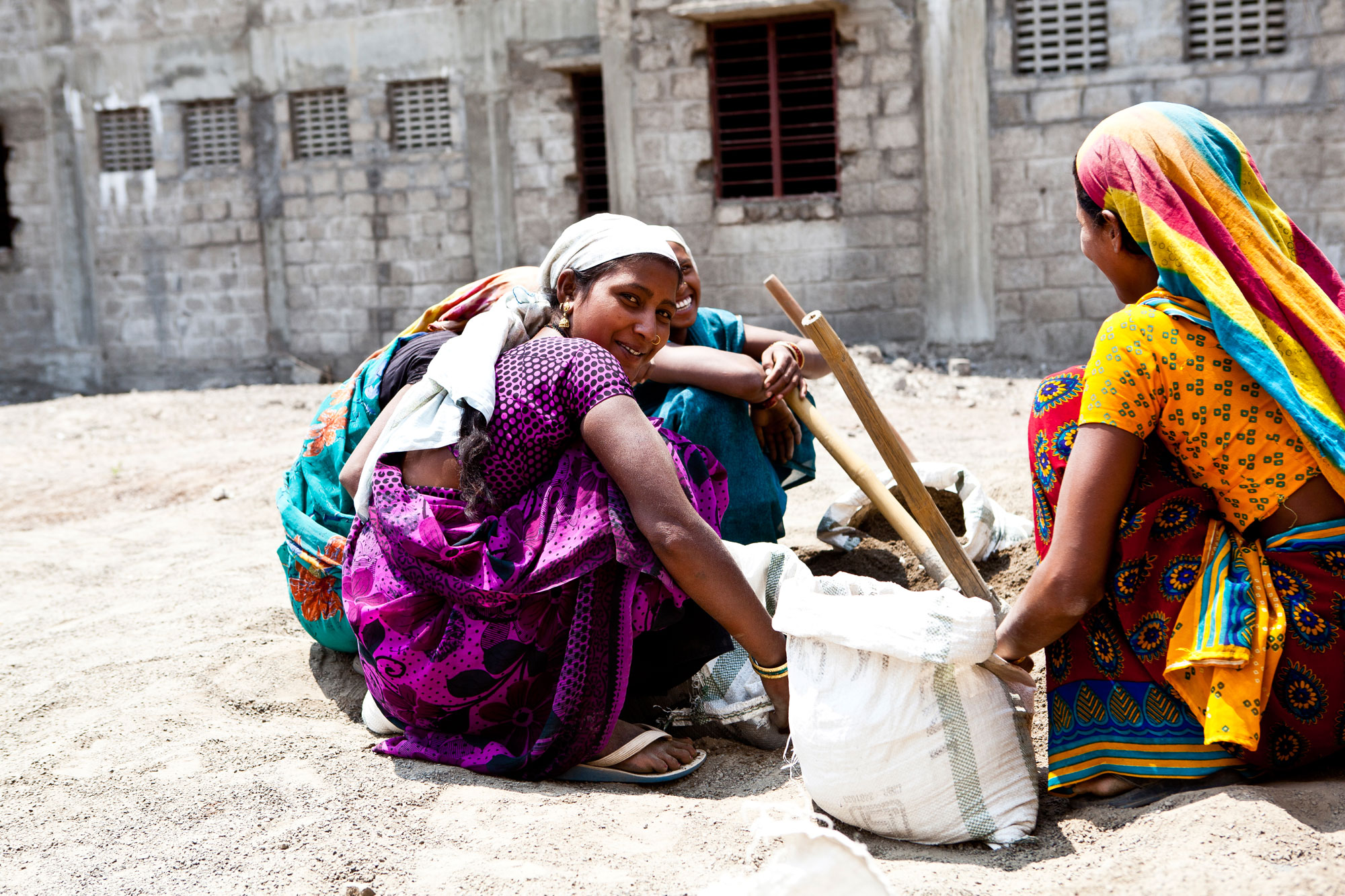“You don’t have to make headlines to be a hero. The ladies from Jaridih, Jharkhand, are addressing issues of domestic violence, family feuds and unemployment through strong rural collectives, or Self-Help Groups (SHGs). IndigoReach (a CSR-initiative of Indigo Airlines) has partnered with PRADAN to empower these SHGs. Village organisations and gender leadership camps (were) initiated to create a knowledge-sharing pool and to build understanding on gender, sex and patriarchy.”
It is, indeed, inspiring to see a corporate celebrating the rural poor women as they valiantly take on patriarchy and make an irreverent foray into taboo issues such as sex, gender and violence. The blurb on the pages of the Hello 6E airline magazine cheerfully announces where the company has invested its CSR funds.
CSR funds are not usually forthcoming for projects that do not offer an opportunity to showcase a brand.
Not for Indigo are the beaten-track investments such as school buildings or sanitation units; or looking for brand-positioning opportunities. Instead, they have drawn on the lessons they have learned from working in the villages and have decided to strengthen ‘girl-power’ within their company. This may be one specific instance of how progressive corporate organisations are reconceptualising their investment in CSR.

Coming from a large nonprofit that is ever-short on funds, it is in the order of things for me to state that CSR funds are not usually forthcoming for projects that do not offer an opportunity to showcase a brand, or when there is no immediate visibility of the company.
Section 135 of the Companies Act 2013 does allow for an assortment of avenues for investment of CSR funds. However, the suggested avenues are only guidelines, so it should be possible for companies to plan and evolve their own ways to identify the investment areas that suit them best, as long as they stick to broader objectives such as eradicating extreme hunger and poverty, the promotion of education, and so on.
Related article: Looking beyond CSR spends
The Act does conceive CSR funds as supplementary to the funds being spent by the government; and, therefore, allows companies to liberally contribute to the PM’s Relief Fund or to Clean India Fund, Clean Ganga Fund, and others.
As per the Ministry of Corporate Affairs, the available data for the Financial Year (FY) 2015–16 show that 5,097 companies spent a total of INR 9,822 crores as CSR. Estimates suggest that the amount would not be less than INR 13,000 crores in FY 2018–19. Compared to the more than three lakh crore rupees that the government puts out for development, every year, this amount may be miniscule, but it has the potential to substantially improve the effectiveness of those funds, if invested imaginatively.

It is an important call for CSR heads to decide on whether they want to supplement the already massive resources of the government, or strategically complement state resources, creating a multiplier effect.
The capabilities of ‘being’ and ‘doing’
Poverty in India is a complex phenomenon. The scale and expanse of poverty and inequality is immense. There are no clear definitions on who is poor; suffice it to say that more than one-third of the world’s most desperately poor people live in India. There is no single silver bullet that will solve the problem of poverty and inequality in India and therefore, any effort at alleviation will have to, as much as possible, address the root causes of poverty rather than just address the symptoms.

Photo courtesy: Charlotte Anderson
Even if we do not agree on who is poor, there is an increasing realisation among everyone that adding a few more rupees to the income of a poor household, though a formidable task, is in itself not a solution to the myriad problems faced by the people.
Amartya Sen, through the articulation of his Capability Approach to understanding human wellbeing, has provided a strong theoretical backing to this notion. Sen has postulated poverty as a lack of capabilities—both being and doing—to lead a good life. As a corollary, development is defined as capability expansion. The ‘being’ capabilities are about whether the person thinks she has the agency to change the status quo (of poverty and misery), and the ‘doing’ capabilities are the capabilities required to actually bring about the change.
The basic tenet is that the poor have the potential to bring about change—both in themselves and the world around them. But how does one stimulate change in a community of people with a deeply limited sense of being and doing? This is where the role of groups comes in. Persons in similar circumstances will mutually support and reinforce each other’s quest for a dignified life. Organisations like PRADAN have chosen to mobilise women from the Dalit, Adivasi, and other deprived communities into SHGs and Federations, which have now emerged as a very powerful pathway to a dignified life.
How collectives expand capabilities
The space for mobilising communities through a process of knowledge and capability building has been the forte of civil society organisations.
Collectives are important because poverty in India is not just an economic issue but a social and political one. Poverty and inequality are perpetrated through the age-old forces of gender, religion, caste, and class, which have built their own fault-lines in the social fabric—unceasingly mediating any change in status quo. Collectives have the confidence to take on these forces. They also have the opportunity to build linkages with external agencies such as government departments, panchayats, markets, and other knowledge institutions, to mobilise the resources they need. Thus, the enormous quantum of resources available with the government, banks, and other technical institutions have a much better chance of being invested more effectively.
The space for mobilising communities through a process of knowledge and capability building has been the forte of civil society organisations, or nonprofits. Civil society has been a trailblazer in the domain of strengthening communities and facilitating sustainable and inclusive development with the community in focus, offering innovative solutions to the deeply entrenched problems of poverty, livelihood, health and education, environment, and so on.
Related article: Making corporate giving effective
Moreover, it has nurtured the spirit of voluntarism in society and has become a space for those interested in a vocation of doing something for others. This has been done by facilitating the entry of educated men and women into the voluntary sector and by encouraging local leadership, mostly women, in the villages and mohallas, to extend themselves in a spirit of citizenship.
Whereas there are many individual samaritans, most of those who enter and remain in the voluntary sector do it because of the existence of vibrant civil society institutions, which provide them guidance, mentoring, and the space for learning—thereby helping them evolve into effective development workers. The CSO space provides the opportunity to pursue their passion and strive for social change, in partnership with the communities with which they work.
Where CSR must focus
This is where the bulk of CSR investments must primarily go—towards nurturing civil society, leading to more holistic development. We need to build institutions in civil society that are inspiring, so that the youth is drawn to dedicate themselves in the long-term and pursue their calling. The CSO space has to evolve as an overarching ecosystem for social change, which orchestrates partnerships with different stakeholders, including the state and the market, and catalyses change at scale.
Related article: The changing CSR-nonprofit relationship—Are we missing the big picture?
Nonprofits are already recipients of CSR resources in a limited manner; these resources are more toward the delivery of specific outputs, in the short-term, and many-a-time, only as service contracts. There is limited money for institution building. The costs of putting in place modern systems, advancing innovation, nurturing talent, ensuring a competitive compensation package, building and disseminating knowledge, and so on, fall in the purview of institution building. The longer-term patient funding and contribution to the corpus is crucial in creating robust institutions. Most of these are not how CSR funds flow to nonprofits today, and there is need for this to change. We need to build enduring partnerships between corporate organisations and CSOs to bring about the transformational change that we envisage in society.
The CSO sector in India is ready today to envision audacious change; it is ready—individually and as networks—to build fair partnerships with large companies and with the state to build the nation together. With many conventional funding routes shutting down, it is important for CSR funds to indeed step in and support CSOs, not from a vantage of donors, but as co-travellers, in mutually rewarding alliances, to build the just and equal society of our dreams.
—
Disclaimer: The views expressed in this article are personal, and not representative of the views held by PRADAN.




